Overhauled originals back overhead
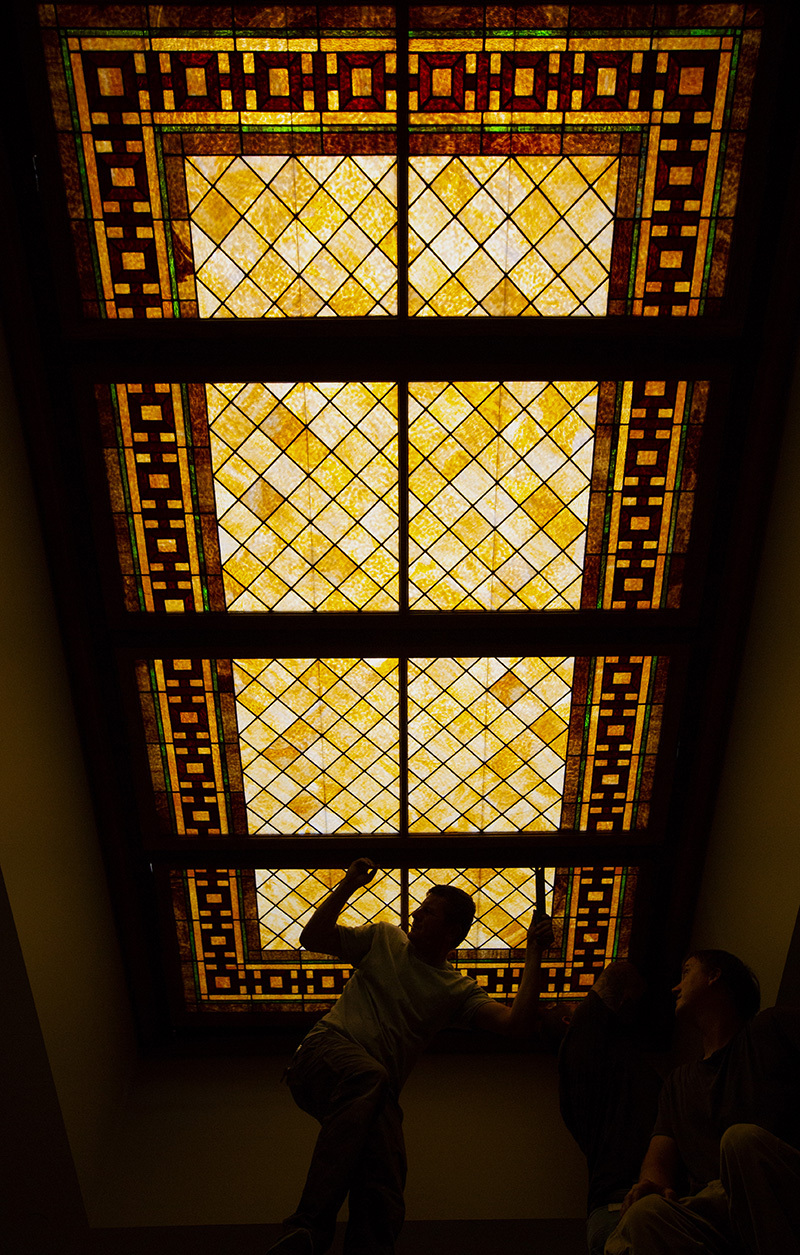
A worker finishes installing stained-glass panes in a skylight on the south side of Curtiss Hall's third floor Aug. 14. The glass is original, dating back to the building's 1909 completion. Photos by Christopher Gannon.
Giving new life to Curtiss Hall's 110-year-old stained-glass skylights, workers reinstalled the eight refurbished panels Aug. 14 as part of the renovation of the building's third floor.
The windows feature the same orangish-brown glass as when construction on Agriculture Hall -- renamed for longtime agriculture dean Charles Curtiss in 1944 -- was finished in 1909, said Kerry Dixon, facilities planning and management project manager. Beardshear Hall is the only other campus building with stained-glass skylights, a decorative touch for ventilating systems no longer used but common at the time in large buildings.
Due to heavy layers of grime on the Curtiss Hall skylights and distracting ceiling lighting, they were an easily overlooked adornment in the building's north and south wings.
"You just didn't get the glory of the windows before," Dixon said.
Removing, refurbishing and reinstalling the skylights was a small part of the $2.3 million third-floor renovation project, which reconstructed much of the floor's hallways and rooms. The skylight work cost less than $50,000, paid in part by the overall project's allocation toward the Art on Campus program, she said. The Stained Glass Store, a Grimes-based company, removed the windows in February to disassemble them, replace the lead linings between glass panes and construct new wooden frames.
Dixon said the restored windows should be much more noticeable.
"They're gorgeous," she said.
The south side of the third-floor project will open next week, including a classroom and open office space for English graduate assistants and lecturers. Offices for College of Agriculture and Life Sciences development, IT and communications staff in the north wing will open shortly after that, Dixon said.
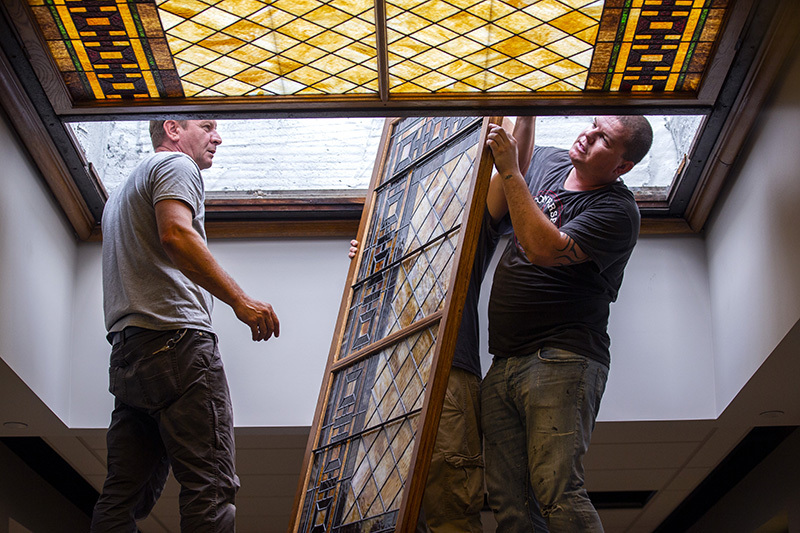
Workers install stained-glass panes in Curtiss Hall. From left is Edin Hosic, Nate Hatfield (obstructed) and Admir Hosic of The Stained Glass Store, Grimes.
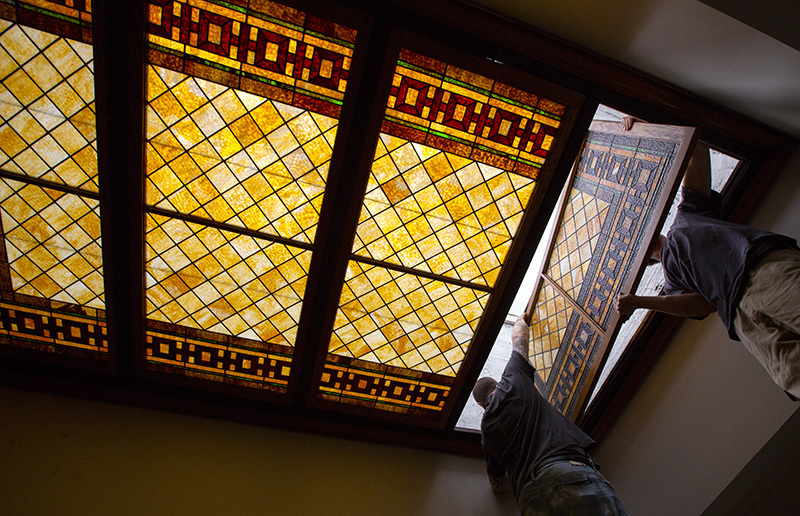
Workers from The Stained Glass Store in Grimes restored the original stained-glass skylights in Curtiss Hall, making minor glass repairs while replacing the leading between each individual glass piece and each panes wooden frame.
Summer programs give undergraduates intense intro to research
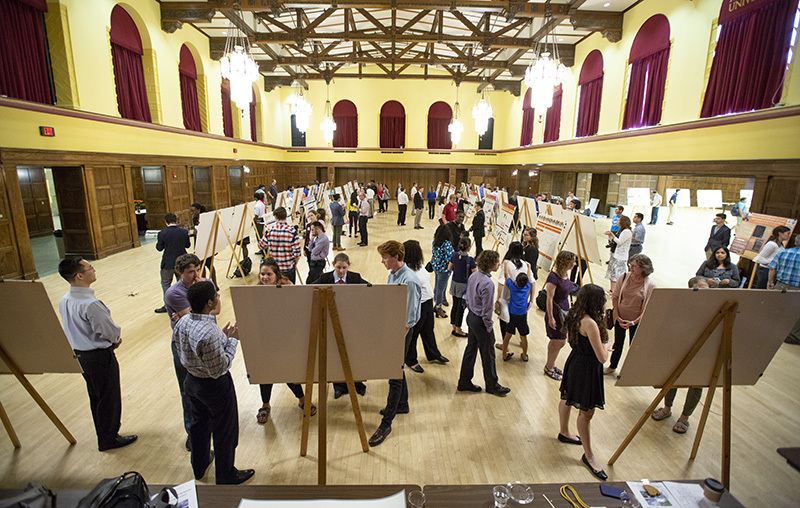
Nearly 150 undergraduates who spent the summer working on research projects presented their findings in a poster presentation symposium Aug. 1 in the Memorial Union Great Hall. In addition to ISU students, presenters included more than 100 students from other schools participating in programs such as those sponsored by the National Science Foundation's Research Experiences for Undergraduates. Photo by Christopher Gannon.
By the third week in Stephen Gilbert's summer research program for undergraduates, most students are freaking out. They're away from home, living and studying with people they just met, doing work without clear answers -- or clear questions.
"It's meant to be intense," said Gilbert, associate director of the Virtual Reality Application Center and the human computer interaction graduate program. "So far in their lives, they've been told, 'Oh, if you do this, you'll get an A. If you do that, you'll get an A.' Now it's like, 'Figure out something clever to do.' We tell the faculty involved, 'Don't go tell them what to do.' Part of research is figuring out what to do."
Introducing undergraduates to the realities of research is among the many goals of the Summer Program for Interdisciplinary Research and Education-Emerging Interface Technologies (SPIRE-EIT), Gilbert said. It's one of several similar programs that invite students from other institutions to the Iowa State campus during the summer to work with researchers on actual projects. Many of them are, like SPIRE-EIT, funded by National Science Foundation's Research Experiences for Undergraduates (REU) initiative. The undergraduates, who often have little or no background in research, are paid a stipend and live in on-campus housing.
"We really are a little like research camp," Gilbert said.
The programs drew more than 100 undergraduates from other universities to the Iowa State campus for the summer, accounting for more than two-thirds of the 146 students presenting their work at the Summer Undergraduate Research Symposium on Aug. 1, according to Svitlana Zbarska, campuswide undergraduate research program coordinator.
Many programs especially encourage underrepresented minorities and female students to apply, including ISU's five REU sites and initiatives such as the College of Agriculture and Life Sciences' George Washington Carver Summer Research Internship Program and the food science and human nutrition department's Cyclone Scholar Summer Research Experience.
One of the largest and most established programs is the Science Undergraduate Laboratory Internships (SULI) program run by the U.S. Department of Energy and offered at numerous DOE sites, including the Ames Laboratory. Twenty-seven undergraduates, one-third of them Iowa State students, participated this summer in the program, which also is offered in the fall and spring.
"These research experiences are a great way to get a taste of research in a real-world environment and see if they like it," said Steve Karsjen, director of education and outreach for the Ames Laboratory. "It's just a great opportunity to impact their future."
More than lab time
All of the programs offer professional development workshops on topics such as planning, writing about and presenting research, applying for graduate school, interviewing and preparing a resume. Zbarska organizes a series of those workshops, and many of the programs have their own seminars, as well. Sessions on team-building and networking are common, and the programs naturally can lead to spotting or recruiting future graduate students. Research experience increasingly is expected of graduate school applicants, Zbarska said.
"Research is a must have. It's not optional. The level of competition is so high," she said.
In SPIRE-EIT's 14-year history, about a dozen students have ended up returning for graduate school, Gilbert said. The program's goal of having students of color and women each account for at least half of every year's group is in part driven by the need to diversify graduate studies.
"Our nation desperately needs more STEM, and there's a whole set of people not contributing who could be," he said.
For SPIRE-EIT's Vrinda Shroff, a junior-to-be studying computer science at California State University, East Bay, this summer helped solidify her tentative thoughts about going to graduate school. Working in a team of three on how to limit disorientation in virtual reality environments was an eye-opening experience, she said.
"Especially for me as an immigrant myself, it was a super-big opportunity to get to know so many people from so many different places and get to know how they work in a team. To learn so much from my teammates -- it was like all of everything. Emotions, learning, outcomes, research, a little bit of everything," Shroff said.
Even though they may feel lost in week three, Gilbert said most students end up thriving and making great strides by the end of their 10 weeks on campus. Students' work is often more helpful to the research projects than they, and their faculty mentors, thought it would be.
"I love the program. It's one of my favorite things I do at Iowa State. It's changing these kids' lives," Gilbert said.
Construction continues at southeast complex; MWL complete
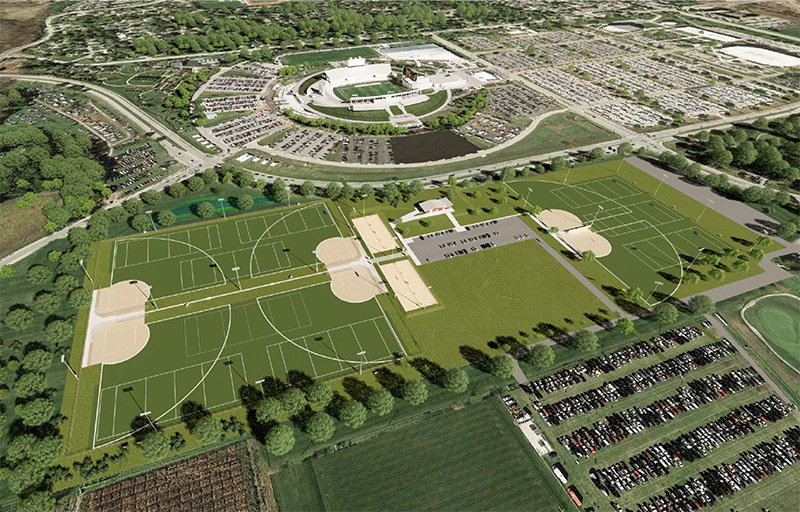
Overview of the layout at the Southeast Recreation Complex. Construction will be completed for fall 2020. Images courtesy of recreation services.
Recreation services is getting closer to having two significant field renovation projects completed, offering students a variety of sports participation options.
The fields east of Maple Willow Larch (MWL) will officially open this fall. The $2.1 million project added lights, scoreboards and irrigation.
"This is the first fall that we open for competition," said Garry Greenlee, recreation services associate director of facility operations. "It has a cricket pitch and multiuse fields for sports like Ultimate Frisbee, lacrosse, soccer and flag football."
The Southeast Recreation Complex, east of Jack Trice Stadium, is in the middle of a $10 million renovation to redesign nearly 30 acres with new turf, lights, irrigation system, pavilion and parking. Softball, sand volleyball, Ultimate Frisbee, soccer and flag football are some of the sports that will be available at the complex.
"It is the renovation I am most proud of and most looking forward to being completed," said recreation services director Mike Giles. "That project has been ongoing for about five years. To actually see it renovated and worked on, and the impact that it will make and have on our students is impressive."
Construction will be completed by fall 2020, at which time the MWL fields will be used more for club sports while the Southeast Recreation Complex will be geared toward intramurals. ISU boasts nearly 5,000 intramural teams.
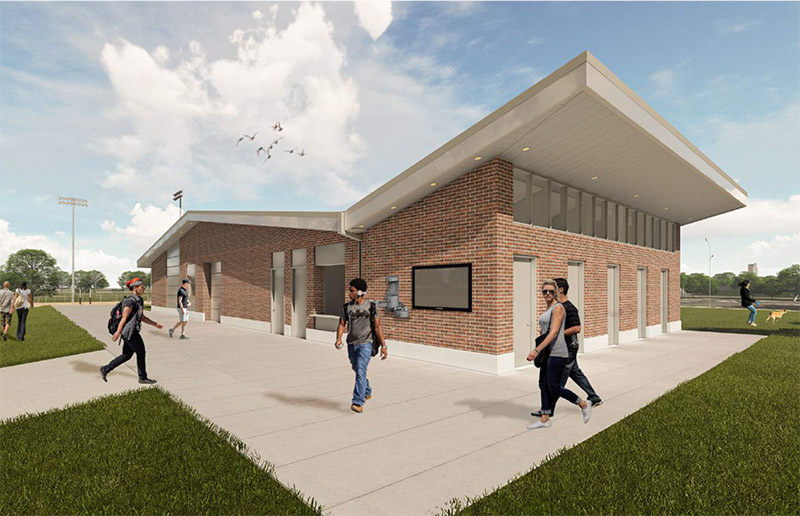
A new pavilion is part of the renovations at the Southeast Recreation Complex.
The addition of lights gives students flexibility with additional time and increased programing available. Improved drainage and irrigation also may extend the season for some sports with fields better able to handle Iowa winters.
More than providing a space for sports, Giles sees recreation services playing an important role in everyday student life.
"It is more than just recreation or providing activity," Giles said. "It is about overall wellness for our students and how engagement can lead to things like a higher GPA or better sleep at night."
When renovations are complete, Giles sees a corridor on University Boulevard and Lincoln Way lit up with student activities on fields at the Southeast Recreation Complex, MWL and Lied recreation fields.
Esports boom
One of the biggest areas of growth for recreation services in recent years is esports -- competitive, organized video gaming.
"Students are engaging in esports in a way that is new to us, and we have to ask how we meet the student demand while still being mindful of some of the challenges that heavy usage inside gaming can have," Giles said.
An emphasis on esports is an example of recreation services meeting the demand of students, not trying to dictate to them. It fits the new campaign "Your Rec, Your Way." Last fall, recreation services hosted an intramural gaming event and plans to host three or four this fall, in addition to programming it already has in place.
Construction beginning soon will turn two Beyer Hall squash courts into an esports room for gamers. The renovation should be completed by fall 2020 and provides more than just a place for gamers to come and play.
"It gives them a space -- from a socialization perspective, development perspective -- to get them out of their res hall where they may be sitting by themselves," Giles said. "It will allow for an egaming team that meets and is very competitive, to just a couple of friends who want to engage in a social environment."
The new room also will have academic uses. Recreation services plans to partner with units to conduct gaming research, Giles said.
Brunnier museum reopens next month
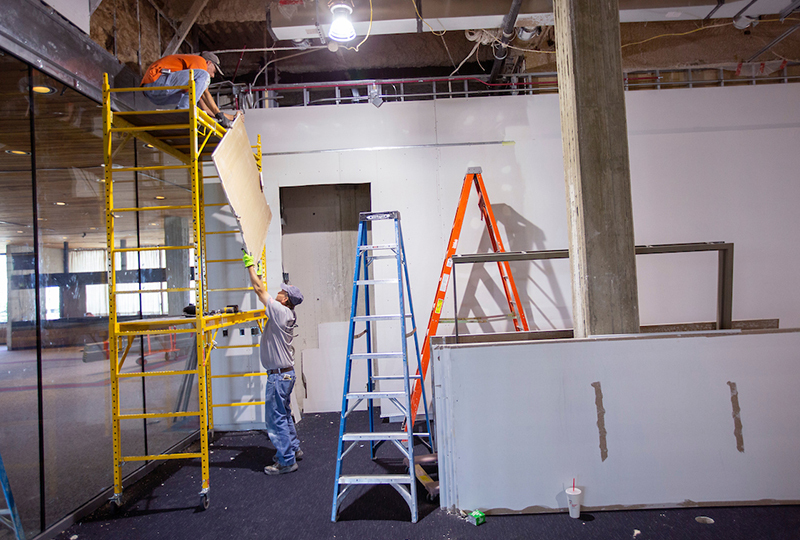
Drywall workers lower a piece for trimming near the front "wall" of the Brunnier Art Museum. Beyond the glass wall is the Scheman Building second-floor lobby. Photo by Christopher Gannon.
A $1.95 million renovation of the Brunnier Art Museum is nearly complete following a 20-month closure for planning and construction. The changes include an all-glass entrance to the museum from the Scheman Building's second-floor lobby, expanded exhibition space, modern storage vault for the collections, new heating-cooling system and reconfigured office space for University Museums staff.
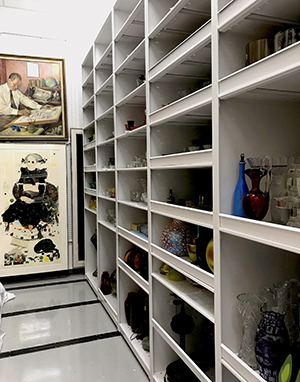
The 20,000-piece Brunnier Art Museum collection was moved to the renovated storage vault this summer. Each piece was cleaned and shelved by category, a process that took staff and volunteers nearly two weeks. Submitted photo.
To celebrate the transformation, University Museums will host a reopening event on Sept. 19, the 44th anniversary of the Brunnier Art Museum. Attendees at the Beyond The Glass gala will have a first opportunity to see the renovated space, enjoy three new exhibitions and be a part of a new public art installation. The Lori A. Jacobson Gallery also will be dedicated. The gala begins at 7 p.m. in the second floor lobby and is free and open to the public.
Beginning Sept. 20, the museum will be open seven days a week when Iowa State is in session; weekdays 10 a.m.-4 p.m. and weekends 1-4 p.m.
Greenlee Summit to focus on civility
Greenlee Summit
When: Sept. 5-6
Where: Thursday-Memorial Union; Friday - Scheman Building
FYI: Thursday's lecture is free and open to the public. A registration fee of $125 for Friday is due by 5 p.m. on Friday, Aug. 23. All attendees except ISU students must register.
With election season in full swing, it's not hard to find conversations on television, social media, radio or newspapers that can turn ugly quickly.
"Every day we wake up with the horrors of what is being said or the crimes being committed. It is important for us to figure out how to treat each other with civility and respect," said Greenlee School of Journalism and Communication director Angela Powers. "Our role as journalists and educators is to practice fair and balanced reporting on these issues, especially in politics and social issues."
The second annual Greenlee Summit, Sept. 5-6, focuses on communications and civility in our democracy. The two-day event brings together Iowa State faculty and staff with industry professionals, community leaders, alumni and students for discussions on ways to promote civility in our interactions.
Organizers are making a concerted effort to draw people from across campus to the summit.
"With the presidential election and the Iowa caucuses coming up, we thought what better way for Greenlee to tie into this election season than to talk about civility," Powers said.

Cupp
Communications faculty will take part in civility exercises with their classes ahead of the event. Readings will be shared with students to prompt discussion on the state of civility around the nation and what that means for professional communicators.
"Our hope is that students can couple the readings with what they hear from the experts on our panels at the summit and have valuable discussions in class about how they can do work that is positive and facilitates civil interactions," said Greenlee School assistant professor Kelly Winfrey.
The summit begins at 7 p.m. Sept. 5, with a keynote address by S.E. Cupp in the Memorial Union Great Hall. Cupp is a political commentator on CNN television, culture critic and author. The talk on trust in the media is free and open to the public.

Gaines-Ross
The discussion continues all day Sept. 6 at the Scheman Building. A $125 registration fee is required (except for ISU students). Leslie Gaines-Ross, chief reputation strategist for Weber Shandwick, a New York City-based public relations firm, will present findings from the "Civility in America" study.
Local, regional and national media and public policy professionals (see list) will be part of breakout sessions that address a range of topics. Panelists will share issues they encounter to help individuals when dealing with incivility, misinformation or distrust. One of the key points will be how to communicate with individuals who hold opposing views.
"We want to create balance in our panelists, so we are trying very hard to be nonpartisan," Powers said. "We don't want people to think we are conservative or liberal, so we are bringing in as many different voices as we can."
The summit concludes with a networking reception.
Breakout sessions
Speakers, panelists and moderators scheduled to appear at the Greenlee Summit:
- Karla Armendariz, Hispanic marketing consultant
- David Begnaud, CBS News
- Lolly Bowean, Chicago Tribune
- Kevin Cooney, retired anchor KCCI-TV
- S.E. Cupp, political commentator
- Aleksander Dardeli, IREX, international nonprofit focusing on education and development
- Leslie Gaines-Ross, Weber Shandwick
- Alexander Heffner, PBS television
- Anne Hillman, freelance journalist
- Melissa Inman, Meredith Corp.
- Joseph Jones, Harkin Institute for Public Policy and Citizen Engagement, Drake University
- Chuck Kaiser, Edelman U.S. Public Affairs
- Jeff Kluever, Robert D. and Billie Ray Center, Drake University
- Mike McCurry, Center for Public Theology, Wesley Theological Seminary
- Walker McKusick, Vote Smart
- Tom Miller, Iowa attorney general
- Noor Naseer, Centro digital advertising software
- Dave Price, WHO-TV
- Sandy Pudar, WGN-TV
- Scott Raecker, Robert D. and Billie Ray Center, Drake University
- Travis Ridout, Washington State University and the Wesleyan Media Project
- Monica Schneider, CLTV and WGN TV
- Rheya Spigner, KCCI-TV
- Ian Stinson, Cox Media Group
Buyers repurpose 58 tons of furniture, housewares at ramp sale
The fourth annual Rummage RAMPage, a community sale designed to keep reusable items out of the waste stream, set records for landfill diversion and proceeds. The city of Ames and ISU's office of sustainability, with assistance from the Volunteer Center of Story County, held the sale July 26-Aug. 3 at the Ames Intermodal Facility.
2019 Rummage RAMPage, by the numbers:
- Nine days spanning two weekends for donations and sales
- 116,424 pounds of furniture and housewares kept out of the landfill, an increase of 14,000 pounds from 2018. One hundred-forty sofas, 138 upholstered chairs, 65 tables and 33,000 pounds of housewares found a new home.
- 22 local nonprofit groups sent volunteers (400 shifts and more than 1,200 volunteer hours)
- $33,194 (an increase of nearly $15,000 from 2018) shared by the nonprofit agencies based on donated hours
"This year's event was truly exceptional in all aspects -- donations, sales and volunteers," said Merry Rankin, who coordinates sustainability programs for both the university and city. "The success or failure of Rummage RAMPage rests in the hands of the community, and once again, the response was overwhelming."
Most leases in Ames expire at the end of July and some relocating tenants discard items that still may be useable. Rummage RAMPage is a collaborative effort to pair unwanted items with buyers seeking low-cost options for furnishing a home.
Most sale items were priced $1 to $50. Not all donated items could be sold. Linens, bedding, clothing, books, unused food and school supplies were distributed to local agencies such as the Ames Animal Shelter, Goodwill and the Ames Public Library. For the second year, Story County Conservation, Iowa Wildlife Center and Ames Animal Shelter partnered to find homes for pets that might otherwise be abandoned. Two turtles were rehomed during the event.
"The end result was that we landfilled less than 2 percent of the total weight of donated items. This helps our recycling and processing of materials at the resource recovery facility," said Bill Schmitt, superintendent of the city's Resource Recovery Plant.
